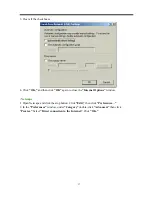
7
A firewall watches all of the information moving to and from your network and analyzes
each
piece of data
. Each piece of data is checked against a set of criteria that the administrator
configures. If any data does not meet the criteria, that data is blocked and discarded. If the data
meets the criteria, the data is passed through. This method is called packet filtering.
A firewall can also run specific security functions based on the type of application or type of port
that is being used. For example, a firewall can be configured to work with an
FTP or Telnet
server. Or a firewall can be configured to work with specific
UDP or TCP
ports to allow
certain
applications or games to work properly over the Internet.
•
VPN – Virtual Private Network
Virtual Private Networking (VPN)
uses a publicly wired network
(the Internet)
to securely
connect two different networks as if they were the same network. For example, an employee can
access the corporate network from home using
VPN
, allowing the employee to access files and
printers. Here are several different implementations of
VPN
that can be used.
•
PPTP – Point-to-Point Tunneling Protocol
PPTP uses proprietary means of connecting two private networks over the Internet.
PPTP
is a
way of securing the information that is communicated between networks.
PPTP
secures
information by encrypting the data inside of a packet.
•
IPSec – IP Security
IPSec provides a more secure network-to-network connection across the Internet or a
Wide Area
Network (WAN)
.
IPSec
encrypts all communication between the client and server whereas
PPTP
only
encrypts the data packets. Both of these
VPN
implementations are used because there is not a standard for
VPN
server software. Because of this, each
ISP
or business can implement its own
VPN
network making
interoperability a challenge.
•
DHCP – Dynamic Host Configuration Protocol
DHCP is a protocol for dynamically assigning IP addresses to networked computers. With
DHCP,
a
computer can automatically be given a unique IP address each time it connects to
a network-
-making IP address
management an easier task for network administrators. When a computer logs on to
the network, the
DHCP
server selects an
IP address
from a master list and assigns it to the system.
•
NAT – Network Address Translation200.
For a computer to communicate with other computers on the Internet, it must have an
IP address.
An
IP (Internet Protocol)
address is a unique
32-bit number
that identifies the location of your
computer on a network. However, with the explosion of the Internet, the number of available
IP
addresses
are simply not enough.








































